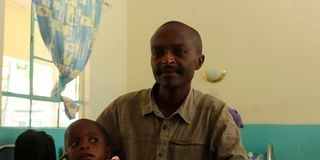Children born with cleft lip gain their smiles forever

John Otieno and his son Cleveland Favour at Homa Bay County Teaching and Referral Hospital.
What you need to know:
- Cleft lip is a birth defect in which a baby’s lip has a gap that exposes the gums and teeth.
- Cleft palate on the other hand makes the roof of the mouth not to form completely and has an opening in it.
- The condition is caused by a combination of genes and other factors such as what the mother comes in contact with in her environment, eats, drinks, or medications she uses during pregnancy.
When John Otieno first set his eyes on his fifth born child three years ago, he recalls questioning his wife whether someone had swapped their son with another infant.
The baby had a deformed face with a cut on the upper lips, leaving his gums exposed.
John was devastated.
His first four children were okay with all body features appearing normal.
The couple could not even give the new born a name as their plans and expectations were suddenly erased from their minds.
The newborn, Cleveland Favour, was active with no signs of being ill. However, his parents main concern was what people would say about the physical appearance of his face. “Babies are supposed to have lovely faces in their first months after birth. My son’s face was different,” says John.
It took him several weeks to understand that his son was suffering from cleft lip and cleft palate.
Cleft lip is a birth defect in which a baby’s lip has a gap that exposes the gums and teeth.
Cleft palate on the other hand makes the roof of the mouth not to form completely and has an opening in it.
The condition is caused by a combination of genes and other factors such as what the mother comes in contact with in her environment, eats, drinks, or medications she uses during pregnancy.

Doctors perform cleft lip and cleft palate surgery at Homa Bay County Teaching and Referral Hospital on Mach 31, 2023.
At his home village in Rodi Kopany, neighbours who visited John’s family as a tradition when a child is born did not get a chance to see the infant during his first weeks after birth.
He would be hidden in a separate room where nobody could see him, especially the family members.
“It was my first time seeing a child with cleft lip and palate. Out of fear of what people would say and not knowing how to explain the condition, we decided to hide him,” John recalls.
A few months later, the father opened up and told everyone about the condition of his son when his health started deteriorating. The baby became malnourished as he was not properly breastfeeding.
His weight dropped, forcing the parents to move him to a hospital in Kisii, where they stayed for a month.
John says he was at a point of giving up when he learnt about a free surgical camp for correction of the lip at Jaramogi Oginga Odinga Teaching & Referral Hospital in Kisumu two years ago. It was an opportunity for the father to put a smile on his son’s face and try and enable him to have good speech.
On March 30,2023, the baby underwent another surgery to repair his palate during a free medical camp organised by Kenya Society of Plastic Reconstructive and Aesthetic Surgeons and sponsored by Smile Train at Homa Bay County Teaching and Referral Hospital.
Hospital Quality Assurance Officer at Homa Bay Referral Hospital Molly Ochar says 17 children had reconstructive surgery to repair the defects.
“Some other patients were referred to Tenwek Hospital while others were booked for surgery, which is scheduled to take place in four months’ time. Doctors said the children had to gain weight,” she says.
A number of parents who took their children for the free medical camp were barely aware of the condition. Ms Maurine Ajwang, a mother of a seven-months-old baby, narrated her struggle moving from one hospital to another in search of help, including having the newborn hospitalised in the Intensive Care Unit.

Maurine Ajwang and her seven-months-old daughter at Homa Bay County Teaching and Referral Hospital.
Dr Dafine Nyairo, a plastic surgeon attached to the University of Nairobi, says cleft lip can be detected through scanning so that parents can start early plans for surgery even before a baby is born. “Sometimes it’s diagnosed when the child is born. But the condition can be detected through ultrasound,” she says.
Other cases of cleft lip may also not be visible to the eye. This happens when the outer skin is intact but the muscle underneath it is separated.
According to Dr Nyairo, , cleft lip and palate is a congenital birth defect which children are born with where the lip and the palate have defects. Normally, the upper lip does not form in full. She says the defects may either occur on one lip, both or in the palate.
Dr Nyairo explains that the condition comes with its own sets of challenges, the main one being difficulties in breastfeeding. “Infants with the condition cannot suction properly. Mothers have to be shown alternative ways of feeding their children, either through supplements of suction,” she says. If left unattended, the condition may contribute to delayed milestones.
Dr Nyairo says cleft lip and palate is not life threatening but parents who do not take their infants for surgery may end up with children who have difficulties in speaking.
“You need your lips and pallet to pronounce some of the letters in a speech. Some of the letters may be different to pronounce if the lips do not have a tight seal.” The medic says surgery and speech therapy enable a child to regain his or her speech.
Though cases of cleft lip and palate are not common, parents with children who get diagnosed often find it difficult to go to health centers due to limited number of experts.
Homa Bay is one of the counties without a specialist to repair cleft lip.
County Deputy director for Curative and Rehabilitative Services Amos Dulo says the aim of the free camp was to help the children have back their smiles.
“This operation is very significant because most patients have been leaving the county to seek services elsewhere,” Dr Dulo explains.
Lack of funds to facilitate medication and movement is one challenge that has hindered the young ones from getting medical attention. “We are from a rural county with low income. Free medical camp is one of the things that families are longing for,” he notes.
Ms Jenipher Mutune from Kenya Society of Plastic, Reconstructive and Aesthetic Surgeons says her organisation decided to visit Homa Bay for the first time in March because the county is underserved.
“We look forward to coming back again to help patients in need of reconstructive surgery. Children with the condition are neglected by the community and we want to change this.”





